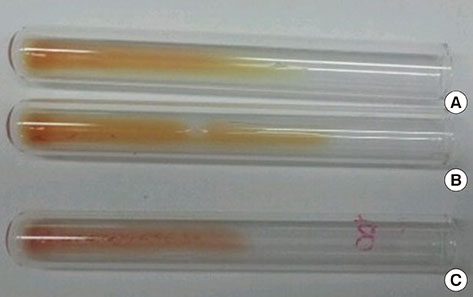Lab Med Online.
2016 Jan;6(1):45-49. 10.3343/lmo.2016.6.1.45.
A Case of the False-negative D Phenotype in a Neonate with a Strongly Positive Direct Antiglobin Test Rest
- Affiliations
-
- 1Department of Laboratory Medicine, Ajou University School of Medicine, Suwon, Korea. limyoung@ajou.ac.kr
- KMID: 2312292
- DOI: http://doi.org/10.3343/lmo.2016.6.1.45
Abstract
- Accurate D antigen blood typing is needed owing to the clinical importance of the Rh blood group. We describe a female infant who was suspected to suffer from Rh incompatible hemolytic disease of the newborn, and who showed a strong positive direct antiglobin test (DAT) result and false red blood cell (RBC) agglutination in D typing. Using chloroquine dissociation of IgG, we confirmed that the antibodies coating her RBCs were of anti-D type. D typing with 0.8% RBC suspensions in saline using saline gel cards showed 2+ RBC agglutinations. After increasing the incubation time of dissociation by chloroquine for up to 4 hr, the dissociated RBCs began to show agglutination in both the tube technique (2+) and the gel card technique (4+) for D typing, although the DAT rest was still positive. Therefore, in order to prevent mistyping as a false-negative D blood group, whenever the D blood typing of a patient with a strong positive DAT rest does not show RBC agglutination, retesting of the D blood typing is recommended by using saline-suspended RBCs or dissociated RBCs.
MeSH Terms
Figure
Reference
-
1. Roback JD, Brenda JG, editors. Technical manual. 17th ed. Bethesda: American Association of Blood Banks;2011. p. 400.2. Roback JD, Brenda JG, editors. Technical manual. 17th ed. Bethesda: American Association of Blood Banks;2011. p. 637.3. Roback JD, Brenda JG, editors. Technical manual. 17th ed. Bethesda: American Association of Blood Banks;2011. p. 406–407.4. Hwang YS. Haplotype frequencies of Rh gene loci in Koreans. Korean J Blood Transfus. 1996; 7:233–240.5. Han KS, Park KU, editors. Transfusion medicine. 4th ed. Seoul: Korea Medical Publishing Co.;2014. p. 102.6. Roback JD, Brenda JG, editors. Technical manual. 17th ed. Bethesda: American Association of Blood Banks;2011. p. 891–892.7. Armstrong B, Smart E. Haemolytic diseases. ISBT SciSer. 2008; 3:93–109.
Article8. Brand A. Fetal, neonatal and paediatric transfusion medicine. ISBT SciSer. 2007; 2:14–21.
Article9. Han KS, Park KU, editors. Transfusion medicine. 4th ed. Seoul: Korea Medical Publishing Co.;2014. p. 193–194.10. Roback JD, Brenda JG, editors. Technical manual. 17th ed. Bethesda: American Association of Blood Banks;2011. p. 500–501.11. Lee SH, Oh YC, Kim KH, Han KS, Han BY, Kim SI. IgG elution method using glycine acid EDTA -comparison to chloroquine method-. Korean J Blood Transfus. 1993; 4:61–66.12. Edwards JM, Mods JJ, Judd WJ. Chloroquine dissociation of antigen-antibody complexes. A new technique for typing red blood cells with a positive direct antiglobin test. Transfusion. 1982; 22:59–61.
Article13. Hannon JL. Management of blood donors and blood donations from individuals found to have a positive direct antiglobin test. Transfus Med Rev. 2012; 26:142–152.
Article
- Full Text Links
- Actions
-
Cited
- CITED
-
- Close
- Share
- Similar articles
-
- Reliability Indexes of Automated Perimetric Tests
- A False-positive Diatom Test in a Non-drowned Victim of Multiple Stab Wounds
- The First Korean Case of RHD-CE(3-8)-D Hybrid Type with a D-negative Phenotype
- Diagnostic Value of the Intradermal Test for the Infection with Clonorchis sinensis
- The role of cervicography in cervical cancer screening



